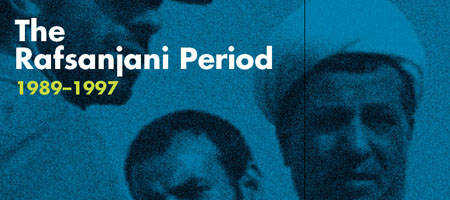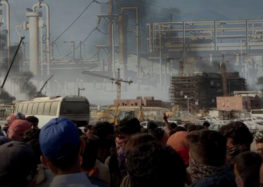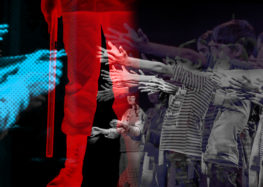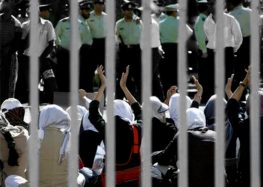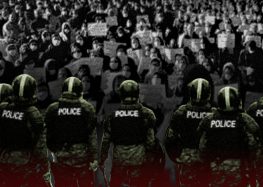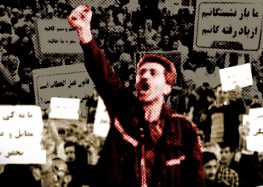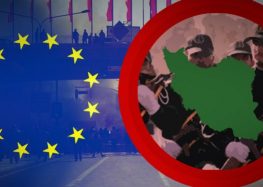The Rafsanjani Period (1989–1997)
A Growing Crisis: The Impact of Sanctions and Regime Policies on Iranians’ Economic and Social Rights
The Rafsanjani Period (1989-1997)
With the exception of the Iran-Iraq Arms Non-proliferation Act, which was signed into law in October 1992, the George H. W. Bush administration (1988-1992) refrained from imposing additional sanctions on the Islamic Republic of Iran. The act, which was sponsored by Senators Al Gore and John McCain, provided for the sanctioning of individuals, countries, and entities that assisted Iran in the development or acquisition of chemical, biological, and nuclear weapons.[23]
America’s unilateral sanctions against Iran, however, expanded substantially during President Clinton’s first term in office (1992-1996). Ironically, the impetus for the intensification of US sanctions against the Islamic Republic was the decision on the part of President Akbar Hashemi Rafsanjani to award a $1 billion contract to the American oil company Conoco as a means of sending a goodwill signal to the US and initiating the process of healing the rift in US-Iran relations, which had become severed due to the hostage crisis in 1979.
Rafsanjani’s outreach to the US, in turn, was a part of his broader strategic vision to bring about realignments in Iran’s foreign and domestic policies and priorities. In the aftermath of the passing of the regime’s charismatic founder in 1989, Rafsanjani felt that the long-term survival of the Islamic Republic could become imperiled if it did not succeed in bringing about an appreciable improvement in the standard of living of the Iranian people, which by 1989 had on average plummeted to about a third of what they had been in 1979.[24] He reasoned that the system’s credibility and the people’s willingness to endure rationing, shortages, and sacrifices might not long endure the death of Khomeini, who had uniquely been able to combine the charismatic, traditional, and popular sources of legitimacy.
To enhance the system’s performance and legitimacy, Rafsanjani felt that it was imperative to generate a sustained expansion of the economy. His planned reforms included: streamlining the bureaucracy, replacing inept ideological purists with pragmatic technocrats, de-nationalizing the economy, promoting private enterprise, rebuilding the nation’s infrastructure, attracting foreign and expatriate investment, reversing the brain drain, rationalizing the subsidies system, integrating Iran into the global economy, and removing unnecessary restrictions on people’s personal and social lives. In short, he sought a repudiation of most of the policies adopted during the first decade of the revolution, and the embrace of the so-called Chinese model—socio-economic liberalization, without meaningful alterations in the power structure.[25]
Rafsanjani recognized that the promotion of the Chinese model necessitated the jettisoning of an aggressive foreign policy. He therefore sought to overcome Tehran’s international isolation by pursuing détente with Iran’s neighbors, improving ties with European countries, and seeking rapprochement with the US, which, he calculated, as the world’s sole remaining superpower at the time, could play an inordinately important role in hindering or assisting Rafsanjani in implementing his vision.
President Clinton, however, citing Iran’s support for terrorism, its opposition to the Arab-Israeli peace process, and its pursuit of weapons of mass destruction, issued Executive Order 12957 in March 1995. In addition to cancelling the Conoco contract, this order prohibited American companies from participating in oil development projects in Iran. Two months later, he issued Executive Order 12959, which imposed a blanket embargo on all American trade and investment in Iran. Thereafter, the US Congress passed, and President Clinton signed, the Iran-Libya Sanctions Act (ILSA) in 1996. This secondary boycott obliged the president, at his discretion (he could waive sanctions if he deemed them inimical to US national interests), to impose at least two out of six sanctions on foreign entities that invested more than $20 million per annum in the Iranian oil and gas industries. Apart from undermining Iran’s oil and gas sector, ILSA sought to appease American oil companies by ensuring that the law would not put US firms at a disadvantage by simply paving the way for their competitors from Europe and Asia to fill the void left by the departure of the Americans.[26]
Yet until the mid 2000s, this is precisely what happened. In the absence of the US oil majors, European, Malaysian, Chinese, and Indian companies were able to win contracts for the development of the Iranian oil and gas industries. Thus, although President Clinton’s executive orders and ILSA managed to increase the external burdens on the Iranian economy and dashed Rafsanjani’s aim of normalizing US-Iran relations, they did not prove to be overbearing. Faced with the opposition of its European partners, who were as yet not ready to terminate profitable business interactions with Iran, the US backed down. American presidents from Clinton to Obama did not apply ILSA (later renamed the Iran Sanctions Act—ISA—after Ghaddafi was partially rehabilitated in 2006) until the expansion of the law in 2010. Instead of carrying out a fight in the WTO with American allies over the extraterritorial nature of the law, US presidents opted to work directly with their European and Asian partners, whereby the US refrained from imposing ILSA in return for its partners’ vigilance in not selling conventional and dual use technologies to Iran. At the same time, until 2010, loopholes in the American sanctions against the Islamic Republic allowed the foreign subsidiaries and branches of American companies, such as Halliburton, General Electric, and Coca-Cola, to engage in trade and investments in Iran.[27]
This is not to argue that ILSA and the executive orders issued by President Clinton did not exact costs on the Iranian economy, which were subsequently passed on to the Iranian people. Shortly after the imposition of President Clinton’s first executive order, the value of American dollars sold on the Iranian black market increased from 2,500 rials for each dollar to 6,500 rials.[28] Thereafter, the plunge in the value of the Iranian currency, from which it never recovered, continued, causing large increases in the value of non-essential consumer imports and smuggled goods (which were technically ineligible for lower exchange rates reserved for essential items). The decline in the value of the rial also prevented Rafsanjani from achieving a unified currency exchange rate. The continuation of multiple exchange rates for the purpose of distinguishing between imports, in turn, provided ample opportunities for engaging in corrupt commercial transactions. Moreover, American oil companies that were, up to 1995, buying Iranian crude, refining it, and subsequently selling it to non-American or American entities, had to stop doing so after President Clinton’s executive orders. To compensate for the loss of its previous customers, Iran had to bear the costs of storing, slightly discounting, and finding new buyers for the oil that had been previously bought by American companies.[29]
More importantly, due to increased American sanctions and pressure after 1995, Iran’s short-term credit risk and letter of credit (LC) fees rose, causing the country’s cost of capital to increase. As a result, depending upon the year, Iran was forced to endure additional borrowing costs of between $29 and $164 million per annum.[30] At the same time, “the mark-up of imports of US goods through Dubai [was] estimated at 20 percent.”[31] This mark-up lasted until the mid 2000s, when American and international sanctions against Iran began to get tougher. Because of US opposition, Iran was also forced to pay increased debt rescheduling fees between 1993 and 1995. The Islamic Republic had purposefully borrowed only miniscule amounts of money from abroad during the first 10 years of its existence. With the end of the war, the inauguration of Rafsanjani, and the attempt to promote hitherto suppressed consumerism, the regime relented, and borrowed roughly $30 billion in short-term loans between 1989 and 1993. The bulk of these funds were spent on financing consumer goods (instead of productive investments).[32] American pressure, however, prevented Iran from receiving favorable refinancing and rescheduling agreements under the auspices of the Paris Club (the group of creditor nations), compelling Tehran to pay an additional $8-55 million per annum (depending on the year) for the rescheduling of its short-term loans.[33] Moreover, after 1995, because of US sanctions and Tehran’s inability to access American-made and -patented liquefaction technology,[34] Iran was effectively prevented from transforming itself into a major exporter of natural gas, despite having the second-largest gas reserves in the world. In all, the intensification of American sanctions on Iran under the Clinton administration is estimated to have cost the Islamic Republic about 1 percent of its annual GDP from the 1990s to the early 2000s.[35]
Nevertheless, as was the case during the Khomeini era, the primary causes behind Iran’s underperformance during the Rafsanjani period remained internal. Although the rate of average annual economic growth accelerated during 1990-1995, this rate was unbalanced due to borrowed external financing, and plummeted to 3.8 percent between 1995 and 1997.[36] Moreover, growth was inequitably distributed and the income gap widened. With baby boomers beginning to enter the job market, consistently high rates of unemployment and inflation, which hit wage earners especially hard, continued unabated.[37] Although oil production increased and much of the damage inflicted on the nation’s infrastructure during the Iran-Iraq War was repaired, the country became more dependent on petroleum, and the task of economic diversification remained unfulfilled.[38]
Rafsanjani’s privatization plans were also not carried out. Although the quality of some administrators improved, governmental and quasi-governmental bureaucracies remained intact, and even managed to expand their size and influence. They continued to antagonize entrepreneurs, undermine privatization plans, and detract from economic development and job creation. Subsidy rationalization and exchange rate unification were postponed, and needed foreign direct investment (FDI) outside the oil and gas industry remained miniscule.[39] Crucially, the Revolutionary Guards, who had been kept in the barracks during the Khomeini period, were allowed, indeed encouraged, to enter the economic domain,[40] placing yet another (and even more formidable) hurdle to the promotion of efficiency and the ability of Iranians to fulfill their economic rights.
On the positive side, education, literacy, healthcare, and infrastructure expanded, the country became more interconnected, and some modern amenities (electricity, piped water, paved roads) were introduced to the countryside. In retrospect, Rafsanjani’s most significant achievement was his decision to launch a substantial expansion of the Islamic Azad University System,[41] which now educates more than half of the nation’s college students.
[23] Richard Sabatini, “Economic Sanctions: Pressuring Iran’s Nuclear Program,” 2010.
[24] Hossein Askari, “Iran’s Economic Vulnerability: Self-Inflicted, Not Sanction-Driven,” isideIRAN.org, November 10, 2009, http://www.insideiran.org/news/iran%E2%80%99s-economic-vulnerability-self-inflicted-not-sanction-driven/. See also Jahangir Amuzegar, “Iran’s Economy and the US Sanctions,” Middle East Journal, Vol. 51, No. 2, Spring 1997.
[25] Ervand Abrahamian, A History of Modern Iran, New York: Cambridge University Press, 2008, pp. 182-195 and Said Amir Arjomand, After Khomeini, New York: Oxford University Press, 2009, pp. 56-71.
[26] Richard Sabatini, “Economic Sanctions: Pressuring Iran’s Nuclear Program,” 2010. See also Nikolay A. Kozhanov, “US Economic Sanctions Against Iran: Undermined by External Factors,” Middle East Policy, Vol. 18, No. 3, Fall 2011.
[27] Kenneth Katzman, “Iran Sanctions,” paper presented to the Congressional Research Service, July 20, 2011, p. 16, cited in Nikolay A. Kozhanov, “US Economic Sanctions Against Iran: Undermined By External Factors,” 2011, footnote 6.
[28] Suzanne Maloney, “Sanctioning Iran: If Only It Were So Simple,” Washington Quarterly, Vol. 33, No.1, January 2010, p. 140.
[29] Askari, et al., 2001, p. 5.
[30] Ibid, p. 8.
[31] Ibid, p. 6.
[32] Askari, “Iran’s Economic Policy Dilemma,” 2004.
[33] Ibid, p. 8.
[34] Suzanne Maloney, 2010, p.140.
[35] See Akbar E. Torbat, “Impact of the US Trade and Financial Sanctions On Iran,” The World Economy, Vol.28, No. 3, March 2005.
[36] Askari, “Iran’s Economic Policy Dilemma,” 2004, p. 655.
[37] Ibid.
[38] Hooshang Amirahmadi, “An Evaluation of Iran’s First Development Plan and Challenges Facing the Second Plan,” Iran Nameh, Vol. XIII, Nos. 1 & 2, Winter 2005.
[39] See Jahangir Amuzegar, Iran’s Economy Under the Islamic Republic, 1997.
[40] See Ali Ansari, “The Revolution Will Be Mercantilized,” The National Interest, February 11, 2010, http://nationalinterest.org/article/the-revolution-will-be-mercantilized-3332.
[41] “The Battle Over Islamic Azad University,” Foreignpolicy.com, July 12, 2010, http://mideast.foreignpolicy.com/articles/2010/07/12/the_battle_over_islamic_azad_university

